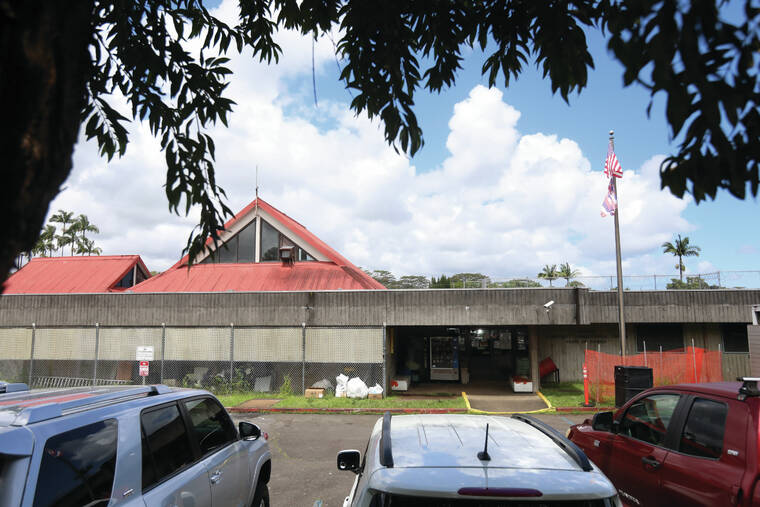‘There’s going to be a breaking point’

KELSEY WALLING/Tribune-Herald Deputy Public Defender Jon Ikenaga urged the state’s high court to reduce the population at Hawaii jails – Hawaii Community Correction Center in Hilo is pictured Wednesday – because of COVID-19.
After reading a state report highlighting abysmal conditions at the Hawaii Community Correctional Center, a Hawaii County Council member is urging the facility to be moved elsewhere.
After reading a state report highlighting abysmal conditions at the Hawaii Community Correctional Center, a Hawaii County Council member is urging the facility to be moved elsewhere.
Hilo Councilman Aaron Chung will present a resolution at Wednesday’s meeting of the Committee on Governmental Operations, Relations and Economic Development calling for the relocation of the jail after a scathing report by the Hawaii Correctional System Oversight Commission in August that highlighted the facility’s terrible health and safety conditions.
“I know it’s just a resolution, but at least this way the Legislature will have something in hand that says what the county government thinks about it whenever they decide to do something,” Chung said.
The nonbinding resolution does not urge a specific action from a specific agency, but states that because of the systemic dysfunction of the facility, it is in the best interests of the Hilo community for it to be moved to an area that can accommodate a proper expansion of the facility.
Chung said that he would prefer to see the entire facility relocated, but added that opening a secondary jail site to handle the excess inmates would be acceptable.
“I know it’s going to be almost cost-prohibitive,” Chung said, estimating that a new jail would cost about $100 million at the very least. “But with where it’s going now, there’s going to be a breaking point.”
The facility is also increasingly ill-suited for the area, Chung said. With the overcrowded jail located near Hilo Intermediate and Hilo High schools, in the middle of a residential area, the facility has become “unnerving” to residents, he said.
But Chung also acknowledged that, with a $20 million expansion currently underway at HCCC, state lawmakers will probably be unwilling to countenance building a new jail anytime soon. But, the resolution notes, even when the expansion is completed next year, it will add only 48 new beds, which is not enough to bring the jail back down to its maximum capacity.
Chung said the commission’s report validated what has been known about the facility for years: extreme overcrowding is a constant problem, while basic minimum standards of living set by the federal government are going unmet.
During a monthly meeting of the Oversight Commission last week, Christin Johnson, commission oversight coordinator and co-author of the report, said HCCC’s conditions are worse than prisons widely regarded to be among the worst in the country.
“I started here two months, and I moved here from Michigan,” Johnson said during the meeting. “So, I oversaw the Michigan prisons and then eventually I moved to New York City and oversaw Rikers Island. Rikers Island is notoriously known as one of the worst jails in the country, and I don’t think it would be that way if people saw HCCC. … That’s what I want to make very clear to our audience. I think HCCC isn’t in mass news and mass media because people don’t know how bad the conditions are inside.”
Johnson and former state prisons director Ted Sakai produced the 70-page report after a tour of the facility in August. During the commission meeting, Johnson noted that the tour was not an audit or an inspection, but simply a routine visit to familiarize herself with the facility, and yet it found extreme violations of federal standards.
Overcrowding was a major concern in the report. The facility is intended to hold up to 152 inmates, but held 259 during the August tour. Nearly every cell held more inmates than they were intended for, and people were being held in temporary holding cells for weeks or even a month.
Furthermore, inmates have no outdoor recreation options, they have no law library, their mail is delayed by two weeks or more, they are not issued sufficient clothing or hygiene supplies, they have no in-person visits allowed, and those inmates who are on suicide watch are often left unsupervised, Johnson said.
Johnson said jail staff removed bunk beds from a cell because inmates were threatening to flood the cell to protest their living conditions, which she said is itself a violation: “You can’t take away beds for punishment.”
Since the report, some minor improvements have been made, Johnson said. Broken windows have been replaced, new cells are properly locked — previously, several cells have been locked only with padlocks, which is against regulations because of how long it takes them to open in an emergency — and some outdoor recreation has been made available to inmates. But she concluded that any meaningful improvements will have to come from systemic changes, including increased state funding for the jail.
Johnson said she has talked with Tommy Johnson, deputy director for corrections with the state Department of Public Safety, to discuss how quickly people can be removed from the jail. Some of the current inmates, she said, are being held on minuscule bail amounts of $30 or less.
Meanwhile, Christin Johnson said she is also trying to get judges to tour the facility so they can see the conditions for themselves.
“If you’re going to take away somebody’s bail or set it to the point where you know they can’t pay it, and you’re sending them to these facilities, I think it’s absolutely vital that you understand what the facilities look like that you’re sending them to,” Johnson said.
Email Michael Brestovansky at mbrestovansky@hawaiitribune-herald.com.


